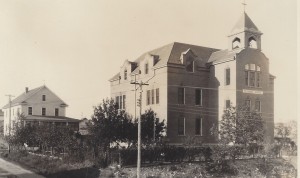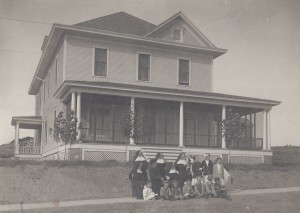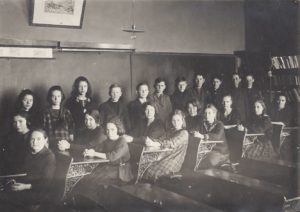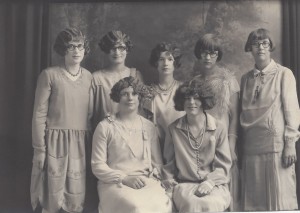
St. Agnes Parish in Kenmare, North Dakota was an important gateway for Catholic mission expansion along the Soo Line Railroad northwest of Minot. In the last years of the 19th century, Mass was held sporadically for the few Catholic families of the district by priests from Minot. On August 17, 1900, Bishop John Shanley came to confirm two children. This ceremony, plus a public lecture by the Bishop, was held in a rented hall.
Father Shaley with the first Ursuline Sisters at Kenmare.
The rectory was built first at St. Agnes. It was a huge frame house that could accommodate a banquet for 250 people on the day that Bishop Shaley dedicated the first church, September 8, 1904. On that occasion, visiting clergy and dignitaries were treated to a buggy tour of the area and to an excursion on the nearby lake in a steamboat furnished by E.C. Tolley. The Bishop confirmed 43 on this visit.
On August 3, 1901, Father Anthony Wagner arrived as the first resident pastor of St. Agnes Parish. He was a native of Germany but educated in an American seminary. His long service extended to 1935 and went far beyond Kenmare, for he built churches in Bowbells, Protal, Tolley, Donnybrook, Noonan, Lignite, Columbus and Colgan. He visited these places by rail and buggy for eight years and deserved the title of “Apostle of Northwestern North Dakota.” Father Wagner died at Dickinson in 1941.
St. Agnes students in the school’s early days.
Father Wagner’s great project was a parochial school, and he erected a large brick building for the Ursuline Sisters he brought from Germany in 1912. St. Agnes School accommodated students from Kenmare as well as boarders from all over the northwest region. The children lived on the third floor, classrooms were on the first floor and the kitchen in the basement.
The Ursulines made Kenmare their first motherhouse in the U.S.A. They also staffed schools at Strasburg and St. Anthony, North Dakota. This arrangement prevailed until 1942 when they transferred their headquarters to Belleville, Illinois. A number of Kenmare women joined the Ursulines during the time they were centered at St. Agnes.
The five first Ursuline Sisters at St. Agnes were Sisters Hildegarde, Nathalia, Carola, Agnes and Cyriaka. A memoir of their arrival in August 1912 reports, “They inspected the schoolhouse, a beautiful building of red stone three stories high, with a spacious basement. On the first floor were four large classrooms, not yet finished. The hall of the second floor was divided by a small wooden partition so that two rooms facing north could be used as living rooms for the sisters. Another room was to be used as a chapel. The dormitories for the boarders were on the third floor, and the kitchen in the basement.”
1928 graduates.
St. Agnes School began with 127 students in 1912 and it usually had about that same number throughout its existence. The largest enrollment was 205 pupils in 1915-1916. The first graduation class of 4 eigth grade students took place on June 12, 1913. A high school department was added in the yearly years, making it a 12-year program. In 1934, the severe drought closed the school for a year. The school was noted locally for its fine music instruction, its annual Christmas tableaux and for the excellent Catholic instruction given by the sisters and priests. With the arrival of Sister Marie Therese in 1913, a music department was opened at St. Agnes School, which flourished until shortly before the sisters left Kenmare in 1962. She taught voice, piano and violin, along with needlecraft and painting. She also directed the parish choir.
1954 basketball team.
The 1930s brought hard times to Kenmare as everywhere and this harsh decade was made worse for St. Agnes by the destruction of its church by fire. The blaze occurred on the night of February 12, 1939. A 60mph wind made it im
possible to control the fire and the wooden building was reduced to ashes within an hour. A basement church was soon erected as a replacement which had to serve the parish until 1951 when the present brick superstructure was completed. The building seats 300 people and has an adjacent rectory.
Sister Libory Jonas with St. Agnes students in the 1950s.
In 1962, St. Agnes School was anticipating its golden jubilee when the Ursuline Sisters announced their withdrawal. The high school had closed in 1958 when Bishop Ryan High School opened in Minot that year. The new high school also was staffed by Ursuline Sisters.





Comments
I enjoyed reading the history of St Agnes.
I grew up near it.